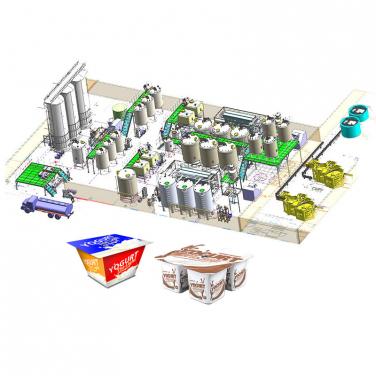
Qingdao HODIAS Food Ingredients Co., Ltd. was established in 1994. Its products include edible essence, food ingredients, chicken essence and chicken powder, compound seasoning, bone soup and bone oil, prefabricated sauce, health drinks, etc.
HODIAS sales network has spread throughout the country and expanded to many countries in Southeast Asia and Africa, building a global marketing network. The newly invested HODIAS Food Industry Park in Zhonghua Flavor Valley is located in Cuijiaji Town, Pingdu City, covering an area of 206.55 acres with a total investment of 750 million yuan and a planned total construction area of 175000 square meters.
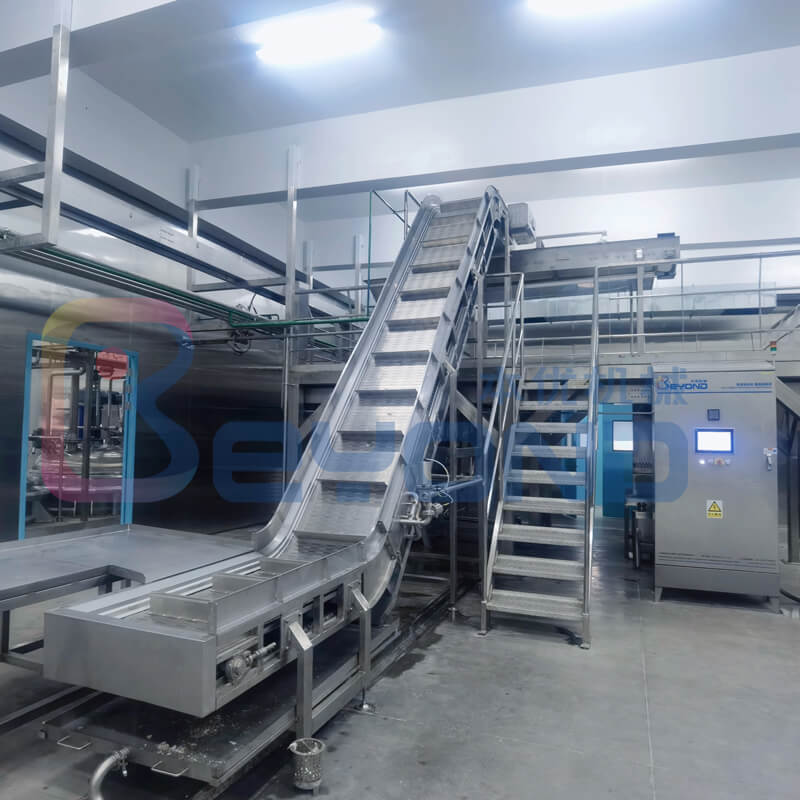
The deep processing production line of bone soup usually includes the following main steps:
1. Aggregate treatment: Firstly, the bones need to be cleaned and impurities removed to ensure the hygiene and quality of the product. Then, the bones can be processed by breaking or cutting to better release their nutrients.
2. Stewing: The processed bones are placed in a large stew pot, with an appropriate amount of water added and heated until boiling. Then, the heat needs to be adjusted to an appropriate temperature to allow the bones to slowly simmer. This process usually takes a long time to fully release the nutrients and taste in the bones.
3. Clarification and filtration: After prolonged stewing, certain turbid substances and impurities will be produced in the bone soup. In order to improve the quality of the product, it is necessary to clarify and filter the bone soup. This can be achieved by using equipment such as filters, gauze, or centrifuges to remove suspended solids and solid particles.
4. Concentration and seasoning: The clarified and filtered bone soup can be further concentrated to enhance its rich taste and flavor. This is usually achieved by further heating the bone soup to allow its moisture to evaporate and reach the desired concentration. During the concentration process, an appropriate amount of seasoning, such as salt, soy sauce, spices, etc., can be added according to the requirements of the product to enhance its flavor.
5. Packaging and sterilization: Finally, the concentrated and seasoned bone soup needs to be packaged and sterilized to ensure the safety and shelf life of the product. Common packaging methods include canning, bagging, or bottling, while sterilization can be achieved through high-temperature sterilization or other appropriate methods.
The above are the main steps of the bone soup deep processing production line, and each step needs to be strictly controlled and operated to ensure the quality and hygiene safety of the product. The specific production line configuration and process parameters can be adjusted and optimized according to different production needs and product characteristics.
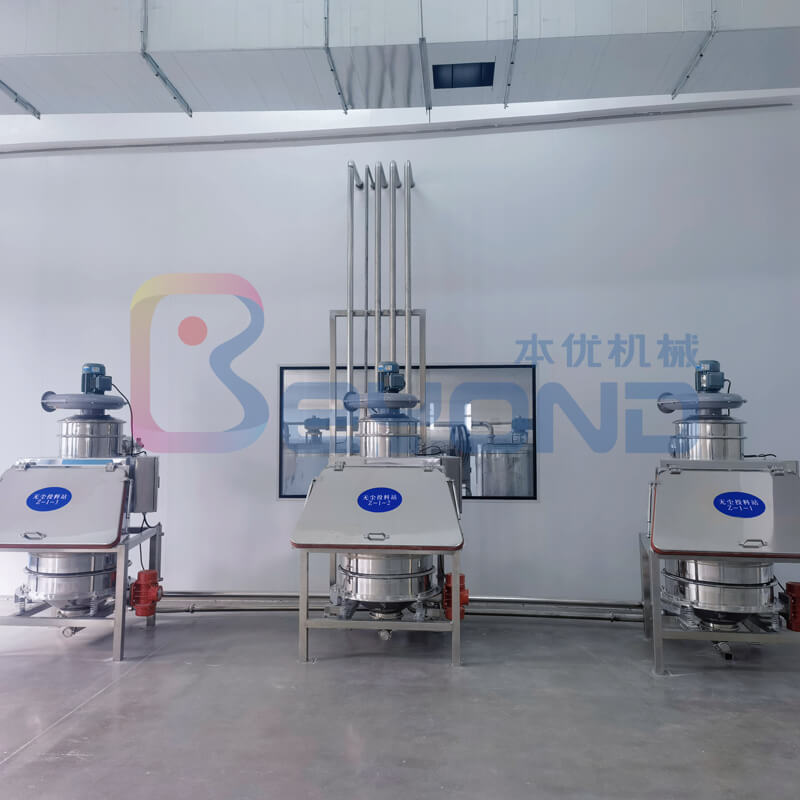
Dust free feeding station
Dust free feeding station is a device used for feeding powder materials, which is mainly used to avoid the generation and diffusion of dust. A dust-free feeding station usually consists of a closed feeding room and a feeding system connected to the feeding room.Dust free feeding station of bone soup deep processing production line.
The dust-free feeding station is an important part of the bone soup deep processing production line, used to accurately supply raw materials to the production line, ensuring hygiene and safety during the production process.
Dust free feeding stations usually include the following main components:
1. Raw material storage warehouse: used to store raw materials such as bones, vegetables, etc. Storage silos are usually designed with sealing to prevent contamination of raw materials by external dust, bacteria, and other contaminants.
2. Conveyor system: used to transport raw materials from the storage bin to the production line. The conveying system can use conveyor belts, screw conveyors, and other methods to ensure continuous supply of raw materials.
3. Pre processing equipment: used for preliminary processing of raw materials, such as cleaning, peeling, cutting, etc. The pre-treatment equipment needs to have efficient cleaning functions to ensure the hygiene quality of the raw materials.
4. Weighing device: used to accurately weigh the weight of raw materials, ensuring that the amount of raw materials supplied each time is accurate and error free.
5. Sensors and Control System: Sensors detect the supply of raw materials and adjust the supply speed and quantity in real time through the control system to ensure the stable operation of the production line.
6. Dust free environment control: By adopting measures such as air filters and negative pressure systems, ensure that the air quality inside the feeding station meets hygiene standards, and avoid contaminating raw materials with dust, bacteria, and other pollutants.
The dust-free feeding station plays a crucial role in the deep processing production line of bone soup. It can improve production efficiency, ensure product quality, and ensure the hygiene and safety of the production process.
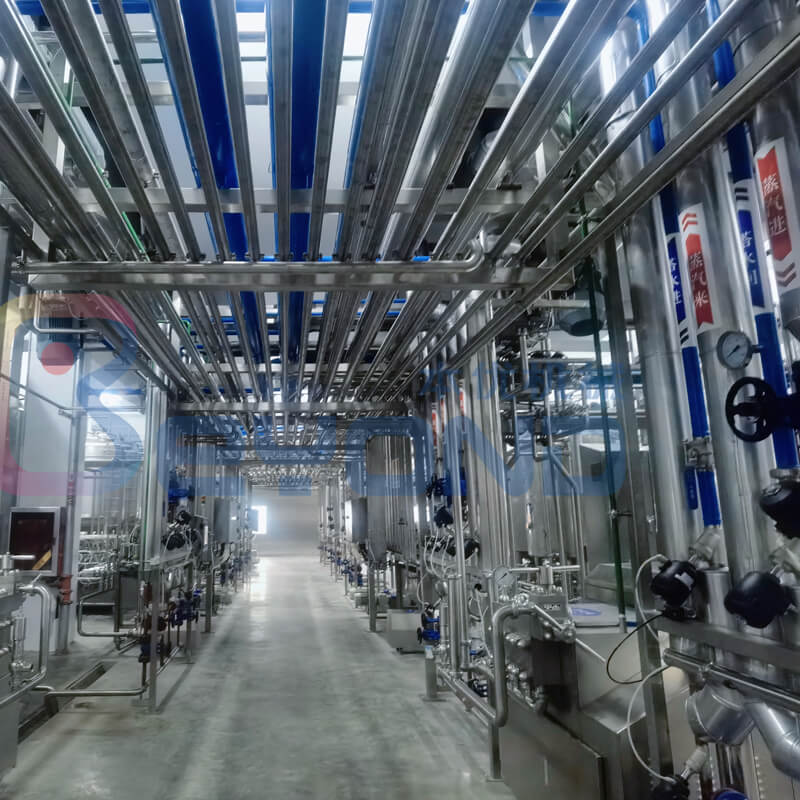
CIP system
The CIP system refers to the Cleaning in Place system, which is an automated cleaning equipment or system used to clean and disinfect equipment, pipelines, containers, etc. during the production process. The CIP system is widely used in industries such as food, pharmaceuticals, beverages, and chemicals to ensure product quality and the hygiene and safety of the production process.
The main purpose of the CIP system is to thoroughly remove dirt, residues, and microorganisms inside production equipment by using a series of cleaning agents, solvents, and water substances, in order to reduce cross contamination and product quality issues. The CIP system can effectively improve production efficiency, reduce manual operations and cleaning time, and reduce the risk of personnel contact during the cleaning process.
The CIP system typically consists of the following components:
1. Cleaning agent and solvent supply system: used to provide cleaning agents, solvents, and water to meet the needs of the cleaning process.
2. Cleaning circulation system: The cleaning agent and solvent are circulated through pipelines and pumps to the inside of the equipment, pipelines or containers that need to be cleaned, in order to achieve thorough cleaning.
3. Control system: used to monitor and control parameters during the cleaning process, such as temperature, flow rate, and cleaning agent concentration, to ensure cleaning effectiveness and safety.
4. Emission system: used to treat and discharge the waste liquid and exhaust gas generated during the cleaning process to meet environmental protection requirements.
The operation steps of the CIP system generally include the following stages:
1. Pre flushing: Use clean water or pre flushing agent to perform a preliminary flushing of the equipment to remove most soluble dirt and residues.
2. Alkaline cleaning: Use alkaline cleaning agents to cycle clean the equipment to remove oil, protein, and other organic matter.
3. Acid cleaning: Use acidic cleaning agents to cycle clean the equipment to remove inorganic salts and metal oxides, etc.
4. Neutralization and final flushing: Use a neutralizing agent to neutralize the equipment and perform a final flushing to ensure complete removal of cleaning agents and residues.
5. Disinfection: Use disinfectants to disinfect equipment to kill microorganisms and bacteria.
6. Final flushing and discharge: Conduct a final clean water flushing, and treat and discharge the waste liquid and exhaust gas.
In summary, a CIP system is an automated cleaning equipment or system that thoroughly cleans and disinfects production equipment by using cleaning agents, solvents, and water to ensure product quality and the hygiene and safety of the production process. It plays an important role in industries such as food, pharmaceuticals, beverages, and chemicals.
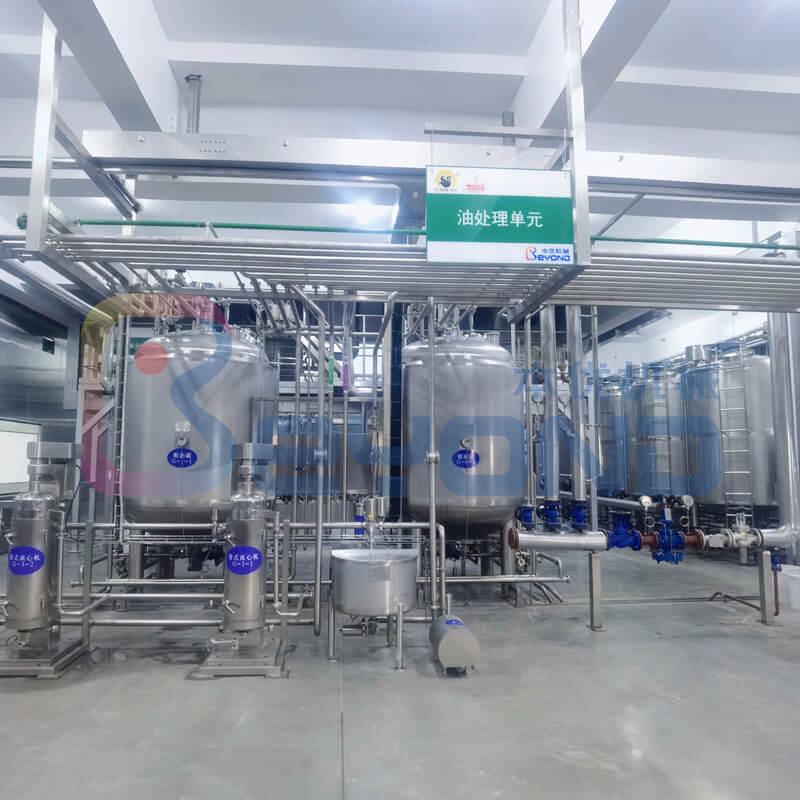
The processing flow of the bone soup oil treatment device is as follows:
1. Pre treatment: Send the bone soup oil into the pre-treatment unit for preliminary treatment. This includes removing suspended solids, solid particles, and impurities. Usually, physical methods such as filtration, precipitation, or centrifugation are used to remove most solid impurities.
2. Dehydration: The pre treated bone soup oil is sent to the dehydration unit to remove any moisture. Common dehydration methods include hot steam dehydration, vacuum distillation, and molecular sieve adsorption. Through these methods, the moisture content in bone soup oil can be effectively reduced, and its stability and shelf life can be improved.
3. Deodorization: After dehydration, the bone soup oil may still have an unpleasant odor or odor. Therefore, deodorization treatment is needed to improve its quality. Common deodorization methods include distillation, adsorbent adsorption, and steam washing. These methods can effectively remove volatile organic compounds and odors from bone soup oil, improving its taste and flavor.
4. Discoloration: In some cases, bone soup oil may have a darker color and require decolorization treatment to improve appearance. Common decolorization methods include activated carbon adsorption, oxidant oxidation, and ion exchange resin adsorption. These methods can effectively remove pigments and impurities from bone soup oil, giving it a clear and transparent appearance.
5. Filtering and refining: After the previous processing steps, bone soup oil may still contain small impurities and particles. Therefore, final filtration and refinement are necessary to ensure the purity and quality of bone soup oil. Usually, microporous filters or other fine filtration equipment are used for treatment to remove residual solid particles and microorganisms.
6. Packaging and storage: After the above processing steps, bone soup oil can be packaged and stored. The appropriate packaging method can ensure the long-term storage and quality maintenance of bone soup oil. Common packaging methods include glass bottles, plastic bottles, or metal cans.
It should be noted that the specific bone soup oil treatment process may vary due to different process requirements, equipment configurations, and product quality requirements. The above process is for general reference only and needs to be adjusted and optimized according to specific situations in practical applications.
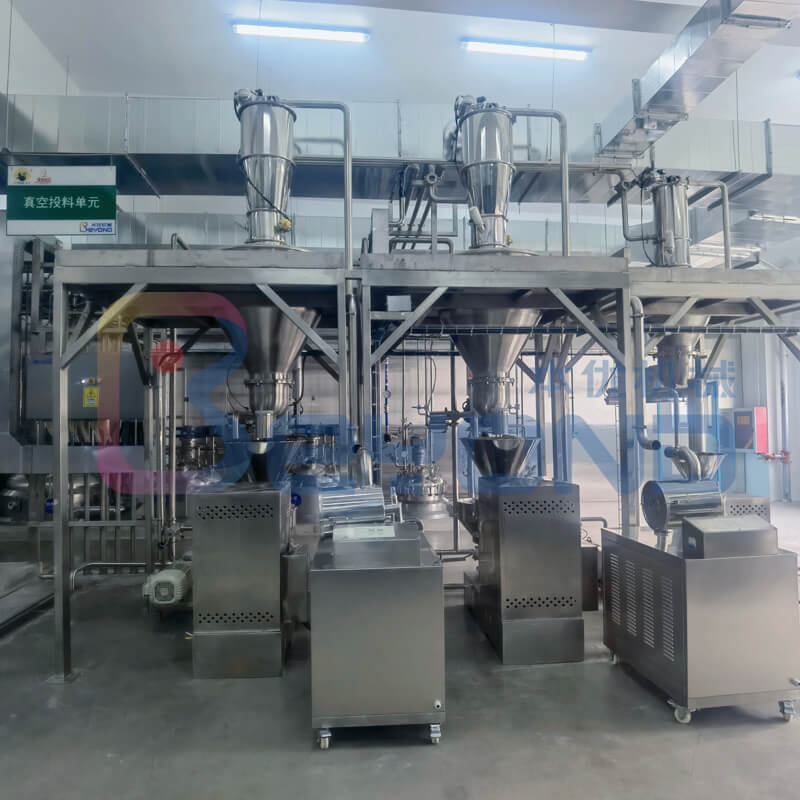
The processing flow of the vacuum feeding device for bone soup is as follows:
1. Prepare raw materials: Collect fresh bones and ensure they are free of any contamination or residue.
2. Cleaning and disinfection: Thoroughly clean the bones to remove surface dirt and blood stains. Then use appropriate disinfectants to disinfect the bones to ensure food safety.
3. Cutting and crushing: Cut cleaned and disinfected bones into appropriately sized blocks or pieces. This can be achieved through manual cutting or the use of mechanical equipment.
4. Stewing: Put the cut bones into the stewing pot in the bone soup vacuum feeding device. Add enough water and other seasonings (such as salt, pepper, etc.) to enhance the taste and flavor of the soup.
5. Vacuum treatment: Start the bone soup vacuum feeding device, which will create a vacuum environment to remove oxygen from the soup. This helps to improve the quality of bone soup and maintain its freshness.
6. Stewing and boiling: In a vacuum environment, stew and boil the bone soup to ensure that all bacteria and harmful substances are completely eliminated. This process usually requires a certain amount of time to ensure that the bone soup meets the safe consumption standards.
7. Filtering and Separation: After boiling, use a filter or other separation device to filter out bone residue, sediment, and other solid impurities from the bone soup. This can obtain clear bone soup liquid.
8. Cooling and packaging: Cool the filtered bone soup liquid to a suitable temperature. Then, pack the bone soup into appropriate packaging containers, such as canned, bagged, or barreled, for storage and sale.
9. Quality inspection and labeling: Conduct quality inspections on bone soup to ensure that it meets relevant food safety standards and regulatory requirements. Then, add appropriate labels to each packaging container, including information such as production date, shelf life, and ingredients.
10. Storage and delivery: Store the packaged bone soup in an appropriate environment to ensure it remains fresh and safe. According to the demand, deliver the bone soup to the seller or end consumer.
This is the general processing flow of the vacuum feeding device for bone soup, and the specific steps may vary depending on the equipment and production scale.
The processing flow of the intelligent distribution unit for bone soup is as follows:
1. Bone soup supply: Firstly, there needs to be a link for bone soup supply. This can include the procurement or collection of bones, as well as the preparation of other raw materials. Ensure that the bones used are fresh and of high quality to ensure the taste and nutritional value of the final bone soup.
2. Cleaning and treatment: After the bone is supplied, it needs to be cleaned and treated. This includes removing blood stains, impurities, and other unnecessary parts. Ensure that the surface of the bones is clean and free from any substances that may affect the quality of the bone soup.
3. Stewing process: Put the cleaned bones into a large pot, add an appropriate amount of water and other seasonings. Then, according to specific stewing time and temperature requirements, carry out a long-term stewing process. This process can be carried out using traditional stoves or modern equipment such as pressure cookers or slow cookers.
4. Intelligent allocation: After the bone soup is cooked and stewed, the intelligent allocation unit will intelligently allocate the bone soup according to preset rules and algorithms. These rules and algorithms can take into account various factors, such as demand, priority, and concentration of bone soup. The intelligent allocation unit will allocate bone soup to different targets, such as restaurants, supermarkets, or other sales channels, based on these factors.
5. Packaging and delivery: Once the bone soup is allocated to the corresponding target, it needs to be packaged and delivered. This includes placing bone soup in appropriate containers and ensuring packaging quality and hygiene standards. Then, deliver the bone soup to the target location through appropriate transportation methods.
6. Storage and sales: Finally, bone soup needs to be stored and sold at the target location. This can include refrigerated or frozen storage to ensure the freshness and quality of the bone soup. At the same time, it is necessary to have sales strategies and channels to push bone soup to the market and meet the needs of consumers.
The above is the processing flow of the bone soup intelligent distribution unit, which involves the supply, cleaning and processing, stewing process, intelligent distribution, packaging and distribution, as well as storage and sales of bone soup. These steps require strict control and management to ensure the quality of the bone soup produced is excellent and meets market demand.
The processing flow of the bone soup mixing jar is as follows:
1. Prepare raw materials: Collect fresh bones, which can be cow bones, pig bones, or other animal bones. Ensure that the bones are free from any contamination or residue.
2. Cleaning and disinfection: Thoroughly clean the bones to remove surface dirt and blood. Then use appropriate disinfectants to disinfect the bones to ensure hygiene and safety.
3. Cutting and crushing: Cut the cleaned bone into appropriately sized pieces to better release bone marrow and nutrients. Mechanical equipment or manual tools can be used for cutting and crushing.
4. Boiling and soaking: Put the cut bones into a large stew or steamer, add enough water to completely immerse the bones. Boil the bones, then reduce the heat and let them simmer slowly. This process helps to release bone marrow and other nutrients.
5. Remove impurities: During the stewing process, some floating foam and impurities may be produced. Use a strainer or spoon to remove these impurities from the soup to maintain its clarity.
6. Adding seasonings: Depending on personal taste and recipe requirements, seasonings such as salt, pepper, ginger slices, scallions, etc. can be added during the stewing process to enhance the flavor of the soup.
7. Continuous stewing: Continue stewing the bone soup for several hours to ensure that bone marrow and other nutrients are fully released into the soup. The stewing time can be adjusted as needed.
8. Filtering and cooling: After the bone soup is stewed, use a filter or gauze to filter out solid residues and impurities, and obtain a clear bone soup. Then cool the bone soup to a suitable temperature for storage or further processing.
9. Packaging and storage: Pour the bone soup into an appropriate container, seal the packaging, and store it in a refrigerated or frozen environment to extend its shelf life.
The above is the processing flow of the bone soup mixing jar, and each step requires strict control of hygiene conditions to ensure the quality and safety of the product.
The energy-saving concentration unit in processing line for bone soup refers to a device or process unit used to reduce energy consumption. In the production process of bone soup, concentration is the process of removing moisture from raw materials, thereby improving the concentration and stability of the product. Traditional concentration methods usually require a large amount of energy supply, so introducing energy-saving concentration units can effectively reduce energy consumption and lower production costs.
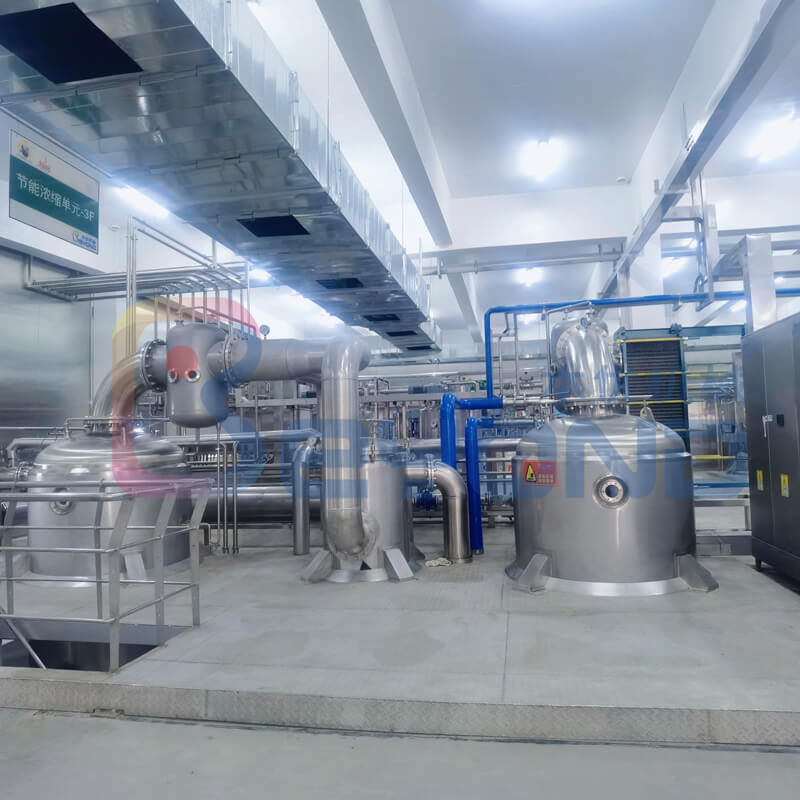
Energy saving concentration units typically adopt advanced technologies and processes to minimize energy consumption. The following are some common energy-saving concentration unit technologies:
1. Evaporator: Evaporator is a commonly used concentration equipment that removes moisture by heating and evaporating liquid raw materials. In energy-saving concentration units, multi effect evaporators or steam recompression systems can be used to reduce energy consumption by recovering and reusing the heat released during the evaporation process.
2. Membrane separation technology: Membrane separation technology includes reverse osmosis, ultrafiltration, and microfiltration, which can separate solutes and solvents through semi permeable membranes to achieve concentration. Compared with traditional thermodynamic methods, membrane separation technology has advantages such as low energy consumption and simple operation.
3. Condensation recovery: In the processing line for bone soup, a large amount of steam and hot gases are often generated. Through condensation recovery technology, the heat in these hot gases can be converted into reusable energy sources, such as heating water or generating electricity.
4. Waste heat utilization: In processing line for bone soup, many processes generate a large amount of waste heat. By properly designing and utilizing waste heat recovery systems, these waste heat can be converted into useful energy, thereby reducing energy consumption.
In addition to the technologies mentioned above, energy-saving concentration units can also achieve energy conservation through optimizing production processes, improving equipment design, and other means. In practical applications, suitable energy-saving concentration unit technology combinations can be selected based on specific production needs and conditions to achieve the best energy-saving effect.
Shanghai Beyond Machinery Co., Ltd
Beyond Machinery specializes in the design and manufacturing of processing line for bone soup. Please contact us now, and our professional technical engineers will customize the equipment plan for processing line for bone soup and provide a quotation. Please contact us now to obtain the latest equipment plan and quotation.


